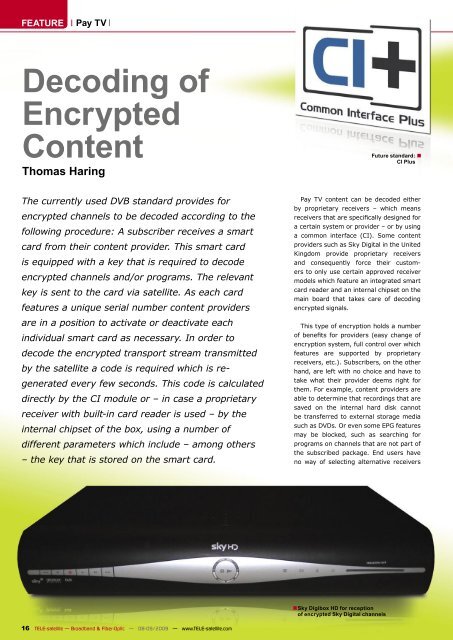08-09 - TELE-satellite International Magazine
08-09 - TELE-satellite International Magazine
08-09 - TELE-satellite International Magazine
Create successful ePaper yourself
Turn your PDF publications into a flip-book with our unique Google optimized e-Paper software.
FEATURE<br />
Pay TV<br />
Decoding of<br />
Encrypted<br />
Content<br />
Thomas Haring<br />
The currently used DVB standard provides for<br />
encrypted channels to be decoded according to the<br />
following procedure: A subscriber receives a smart<br />
card from their content provider. This smart card<br />
is equipped with a key that is required to decode<br />
encrypted channels and/or programs. The relevant<br />
key is sent to the card via <strong>satellite</strong>. As each card<br />
features a unique serial number content providers<br />
are in a position to activate or deactivate each<br />
individual smart card as necessary. In order to<br />
decode the encrypted transport stream transmitted<br />
by the <strong>satellite</strong> a code is required which is regenerated<br />
every few seconds. This code is calculated<br />
directly by the CI module or – in case a proprietary<br />
receiver with built-in card reader is used – by the<br />
internal chipset of the box, using a number of<br />
different parameters which include – among others<br />
– the key that is stored on the smart card.<br />
16 <strong>TELE</strong>-<strong>satellite</strong> — Broadband & Fiber-Optic — <strong>08</strong>-<strong>09</strong>/20<strong>09</strong> — www.<strong>TELE</strong>-<strong>satellite</strong>.com<br />
■<br />
Sky Digibox HD for reception<br />
of encrypted Sky Digital channels<br />
Future standard:<br />
CI Plus<br />
Pay TV content can be decoded either<br />
by proprietary receivers – which means<br />
receivers that are specifically designed for<br />
a certain system or provider – or by using<br />
a common interface (CI). Some content<br />
providers such as Sky Digital in the United<br />
Kingdom provide proprietary receivers<br />
and consequently force their customers<br />
to only use certain approved receiver<br />
models which feature an integrated smart<br />
card reader and an internal chipset on the<br />
main board that takes care of decoding<br />
encrypted signals.<br />
This type of encryption holds a number<br />
of benefits for providers (easy change of<br />
encryption system, full control over which<br />
features are supported by proprietary<br />
receivers, etc.). Subscribers, on the other<br />
hand, are left with no choice and have to<br />
take what their provider deems right for<br />
them. For example, content providers are<br />
able to determine that recordings that are<br />
saved on the internal hard disk cannot<br />
be transferred to external storage media<br />
such as DVDs. Or even some EPG features<br />
may be blocked, such as searching for<br />
programs on channels that are not part of<br />
the subscribed package. End users have<br />
no way of selecting alternative receivers<br />
■

















